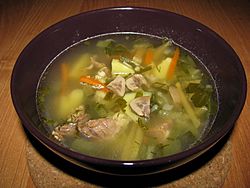Rassolnik facts for kids
 |
|
| Type | Soup |
|---|---|
| Place of origin | Russia |
| Serving temperature | Hot |
| Main ingredients | Pickled cucumbers, pearl barley, pork or beef kidneys |
| Variations | Vegetarian Rassolnik, Leningrad Rassolnik, Moscow Rassolnik |
Rassolnik (Russian: рассольник) is a classic Russian soup. It is famous for its main ingredients: pickled cucumbers, pearl barley, and often pork or beef kidneys. There is also a version of Rassolnik for vegetarians. This soup has a long history, going back to the 15th century. Back then, it was called kalya.
Rassolnik became a very common dish in Soviet cuisine. Today, it is still popular in countries like Ukraine and Belarus. A similar soup is also enjoyed in Poland. There, it is known as zupa ogórkowa, which simply means cucumber soup.
The most important part of Rassolnik is the rassol. This is a special liquid made from the juice of pickled cucumbers. It gives the soup its unique and tangy flavor.
Contents
What's in a Name?
The name Rassolnik comes from the Russian word рассольник. This word is made up of two parts. The first part, рассол (rassol), means "brine." Brine is salty water used to pickle foods. The second part, -ник (-nik), is a common ending in Russian words. So, Rassolnik means "something made with brine." This name perfectly describes the soup, as pickled cucumbers and their juice are key ingredients.
How to Make Rassolnik
Making Rassolnik involves several tasty ingredients. You can use meat like chicken, pork, or beef kidneys. Other important parts are potatoes, pearl barley, carrots, and onions. Of course, you also need the special pickled cucumbers. For extra flavor, dill is often added. The soup is usually served with smetana, which is a type of sour cream.
To prepare the soup, the ingredients are cut into pieces. They are then added to the soup pot step by step. After seasoning, the soup cooks slowly for about 40 minutes. Sometimes, cooked chicken or chopped ham is added at the very end. When it's ready, a spoonful of sour cream and fresh herbs make it even better.
What to Serve with Rassolnik
Rassolnik is often served with fresh herbs. These include dill, onion, and parsley. A dollop of smetana is almost always added on top. Smetana is a popular sour cream in many parts of Europe.
Just like many other Russian soups, Rassolnik is delicious with bread. People often enjoy it with freshly baked bread or pies. Sometimes, it's served with pampushka, which is a type of garlic bread.
A Look at Rassolnik's History
Rassolnik is a very old and traditional Russian dish. It started appearing in Russian cookbooks around the 18th century. But its roots go back even further. It came from older soups that used fermented ingredients. One such soup was Kalya. Kalya was made with chicken or fish, and it used pickled cucumbers or lemons.
The word rassol, meaning brine, has been used in Russian cooking for a very long time. Old writings from the 15th century, like "Writings of Royal Cuisine," mention Kalya. They describe how to make it with lemon brine or cucumber brine. For example, one recipe says, "For a Kalya with a cucumber brine, and chicken, add 10 cucumbers."
Another old mention of brine in Russian food comes from the 16th century. A diplomat named Sigismund von Herberstein wrote about it. He noted that people in Moscow would serve roasted swans with brine, salt, and pepper.
It's not clear exactly when Rassolnik became the soup we know today. But it was widely mentioned in cookbooks by the 19th century. Interestingly, at one point, Rassolnik wasn't just a soup. Some old descriptions, like those by Vladimir Dal, say it was a meat pie. This pie had a filling of pickled cucumbers. The famous writer Nikolai Gogol even mentioned this in his book "Dead Souls". He wrote about Rassolnik as "a pie with chicken and buckwheat, with pickle-juice poured into the filling."
During the Soviet era, a new version became very popular. This was called Leningrad Rassolnik. It was made with beef kidneys. Nikolai Alexandrovich Kurbatov, who created many dishes back then, invented this version. Leningrad Rassolnik used chicken broth. It also added potatoes and carrots to the recipe. Sometimes, rice was used instead of pearl barley.
See also
 In Spanish: Rassolnik para niños
In Spanish: Rassolnik para niños

